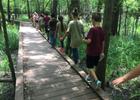Knobby Knees Trail
check with the trail manager for updated details before visiting.
Knobby Knees Trail
U.S. Fish and Wildlife Service
Backcountry Trail
- Length
1 mile
- Elevation Gain
--
- Route Type
Loop
- Length
1 mile - Elevation Gain
-- - Route Type
Loop
Knobby Knees Trailhead is located in Liberty Municipal Park in Liberty, TX. It is a gateway into the bottomland hardwood forests of Trinity River National Wildlife Refuge. From this trail, visitors can explore a network of 9 miles, including 7 other hiking trails and their loops. Several scenic areas await, including Palmer Bayou Boardwalk, Josie Lake, Sycamore Swales, and the sandbars of the Trinity River.
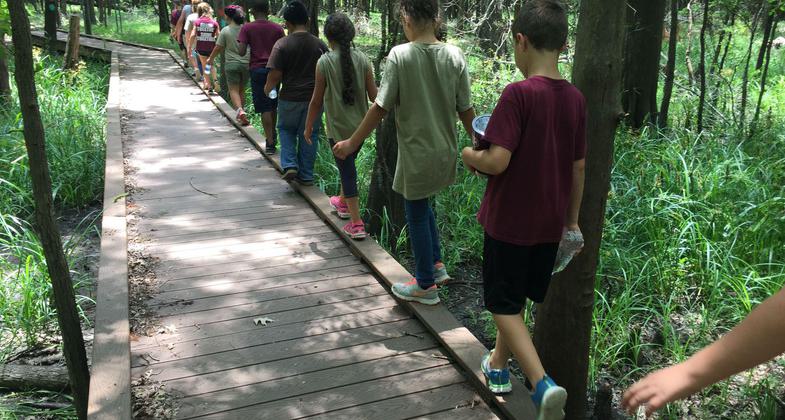
Playing 'Follow The Leader' on Knobby Knees Trail. Photo by Laurie Lomas Gonzales

Houston SCA Crew Member enjoying solitude on the beach of the Trinity River at Arkosisa Oaks Scenic View.
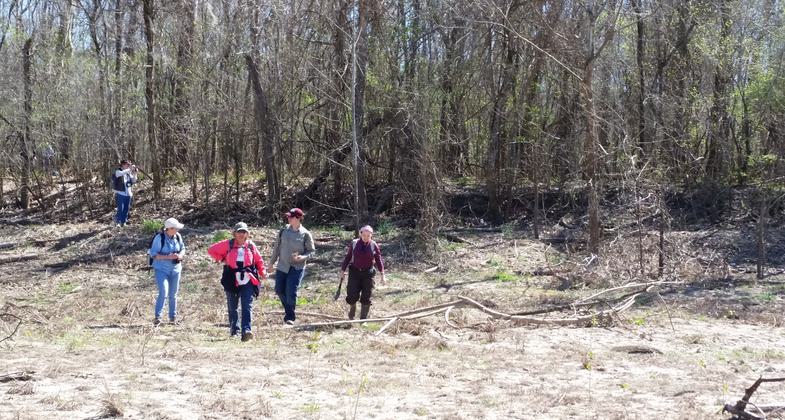
Lower Trinity Basin Master Naturalists exiting the treeline and hiking on the sandy transitional zone to the riverbed at Bobcat Tail Trail Scenic View
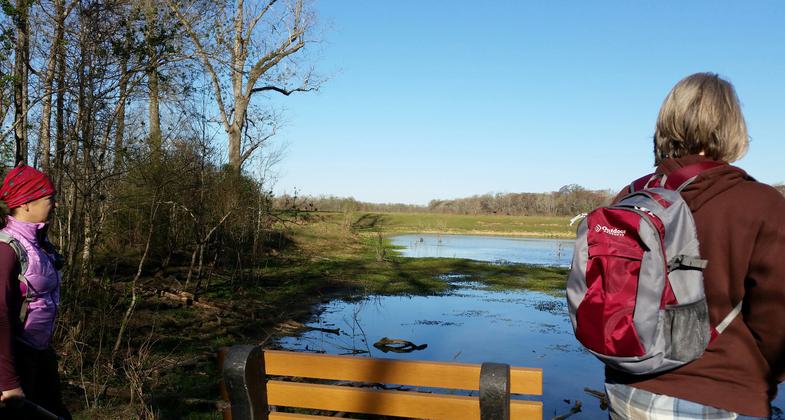
Lower Trinity Basin Master Naturalists viewing the pond at the Knobby Knees Trailhead before their 7 mile hike.
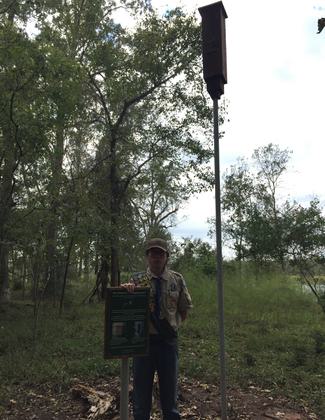
Eagle Scout Eric Medrano with his interpretive project, a rocketbox bat house and signage on the trail hear the Knobby Knees Trailhead.
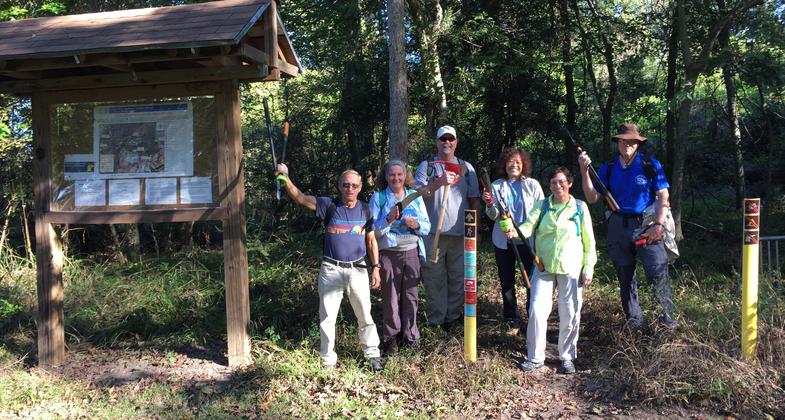
An American Hiking Society Crew getting ready to shape up Knobby Knees Trail

Leos Club of Liberty High School visiting the Palmer Bayou Boardwalk Observation Deck during a volunteer service field trip where they trimmed up the trail.
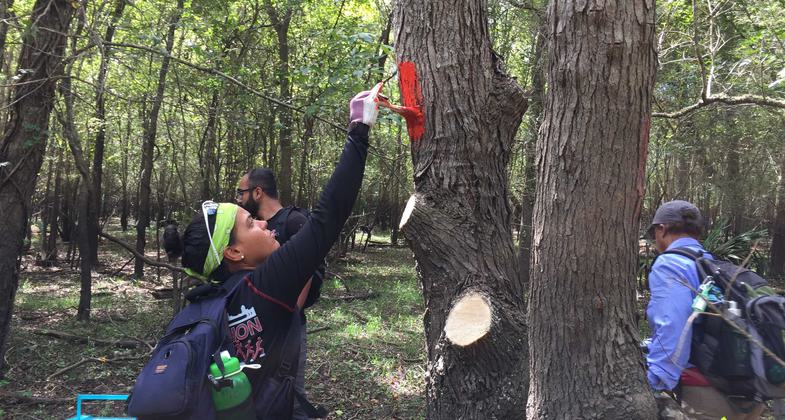
Volunteers from American Hiking Society refreshing the Knobby Knees Trail
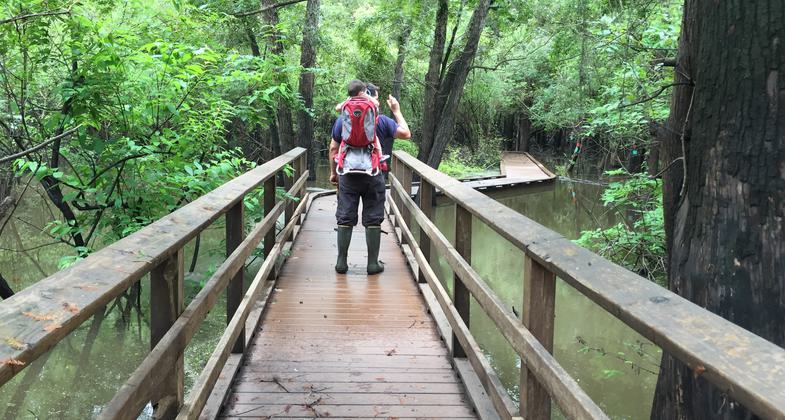
Palmer Bayou Boardwalk over Palmer Bayou

Palmer Bayou Observation Deck
Location: Knobby Knees Trailhead is located in Liberty Municipal Park in Liberty, TX. The Knobby Knees hiking trail crosses north from Liberty Municipal Park into Trinity River National Wildlife Refuge.
- States: Texas
- Counties: Liberty
- Cities/Townships: Liberty, TX
Knobby Knees Trailhead is located in Liberty Municipal Park in Liberty, TX. It is a gateway into the bottomland hardwood forests of Trinity River National Wildlife Refuge. From this trail, visitors can explore a network of nine miles, including seven other hiking trails and their loops. Several scenic areas await, including Palmer Bayou Boardwalk, Josie Lake, Sycamore Swales, and the sandbars of the Trinity River.
The From Crosswalks to Boardwalks Initiative was formed in 2010 with the goal of getting people from the 'crosswalks of the city to the boardwalks of the refuge'. This partnership has created a network of 16 miles of hiking trails which can be accessed through three trailheads. It was designed to be built by the people for the people. Over 800 local and urban volunteers, particularly students, through outdoor service/learning experiences, joined together to create this recreational experience for the public. For some volunteers, it was their first time in the woods despite being surrounded by it all of their lives. We expect the volunteers and hikers of this generation will introduce the next generation, their children, to the trails when the time arrives.
The Knobby Knees Trail, a 1.0-mile loop, was built in October 2012. Since then, eight other miles of trails have been connected directly to the Knobby Knees Trail. The Knobby Knees Trailhead was placed in Liberty Municipal Park as a way of providing equal access for those seeking a space for recreation and exercise in a natural setting. Through the gateway of the Knobby Knees Trail, visitors encounter well-marked primitive hiking trails which traverse the conditions of the forest of yesterday when Native Americans stalked game in the forest in the 1600s, early explorers forged the Atascocita Road (1757), and settlers ran for their lives through a swollen river bottom during the Runaway Scrape (1836).
The Knobby Knees Trail is appropriate for elementary school field trips and hikers seeking an easy, introductory hike. Hikers seeking a multi-mile hike may use the Knobby Knees Trail to access 8 more miles of trails to explore six loops and four additional scenic areas. Hikers seeking backpacking opportunities may not camp on the Refuge or trails, however, they may still use the trails to prepare for that next great trek or to earn merit badges. Anglers can fish from Josie Lake Scenic View. The trailhead and all scenic areas are mapped on Google Maps to help hikers find their trail.
The Knobby Knees trail is located in an active floodplain. As such, certain measures have been taken to ensure the integrity of the trail and reduce the cost and effort of maintaining the trail. Animals know the best ways to traverse a forest in regards to where water pools, the soil is too soft to traverse, and vegetation grows too thick to pass. The framework of the trail was based on animal paths and old logging road scars. The footpath is only cleared of tripping hazards, with foot and nightly animal traffic being the cause of the marked trail on the ground. It is designed to look like a primitive trail, not a wider, sterile trail. Trails are simply blazed by paint in the trees and cleared of scratching hazards from the brush.
Volunteers also built the infrastructure along the Knobby Knees Trail. Palmer Bayou Boardwalk and observation deck are located at the mid-point of the Knobby Knees Trail. This scenic view was constructed by volunteers from AFL-CIO Union Sportmen's Alliance Work Boots on the Ground Program using recycled plastic lumber and Diamond Piers. This technique was used to mitigate damage to the sensitive bald cypress wetland. Four Boy Scouts earned their Eagle Awards on the Knobby Knees Trail for their contributions to a kiosk, bike rack, benches, and a bat tower complete with interpretive signage.
The Knobby Knees Trail and associated trails were meant to be touched and tackled. Trails playfully wind between trees sometimes only three feet apart to bring visitors even closer to nature so they may touch it and observe it up close. Larger logs and brush piles have been left in place to give children platforms to climb over and play. Leaving these structures of wildlife habitat also improves wildlife observation for visitors.
The entire trail system is within the canopy of the forest and is an innovative example of cost-effective techniques for trail modeling and planning. Two other trailheads (Great Egret's Ridge Trailhead and Tree Frog Trailhead) are also located within two miles offering 7 more miles of trails servicing another part of the community). All three trailheads are accessible by bicycle routes which traverse the city to connect people from their neighborhoods to the trailheads. All trailheads also have bike racks.
The From Crosswalks to Boardwalks Initiative is a partnership with many organizations and volunteers through just some of the following organizations: Liberty Independent School District, Premier High School of Dayton, American Hiking Society, Green Ambassadors, Boy Scouts of America, AmeriCorps NCCC, Student Conservation Association, American Conservation Experience, religious organizations, professionals with AFL-CIO, Houston-Galveston Area Council, Houston Wilderness, Texas Parks and Wildlife Department, City of Liberty, Liberty Community Development Corporation, Friends of Trinity River Refuge, and Trinity River National Wildlife Refuge (US Fish and Wildlife Service).
Accessibility Information
No text provided.
Allowed Uses:
Dogs, on leash Hiking/WalkingOther Activities
- Fishing
- Wildlife viewing / observation
Public Contact
Laurie GonzalesUS Fish and Wildlife Service
PO BOX 10015
Liberty, TX 77575
[email protected] • (936) 336-9786
Contact the trail manager for current maps and visiting details.
More Details
- Elevation (low): 17
- Elevation (high): 29
- Elevation (cumulative): --
- Part of a Trail System? No
- Surface (primary): Soil
- Surfaces (additional): Boardwalk, Grass or Vegetation, Soil
- Tread Width (average): 48"
- Tread Width (minimum): 12
- Running length (minimum): --
- Tread Grade (average, percent): --
- Tread Grade (maximum): 9
- Running length (maximum): --
- Cross-slope (average, percent): 0
- Cross-slope (maximum): --
- Running length (maximum): --
- Certified as an NRT
Oct 23, 2020

